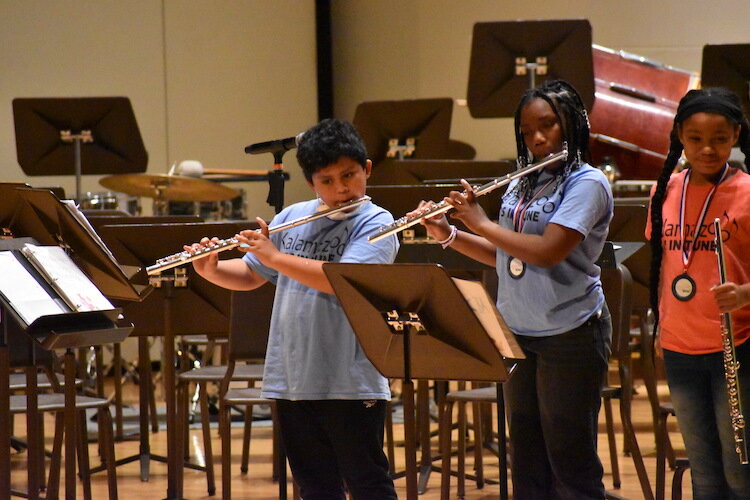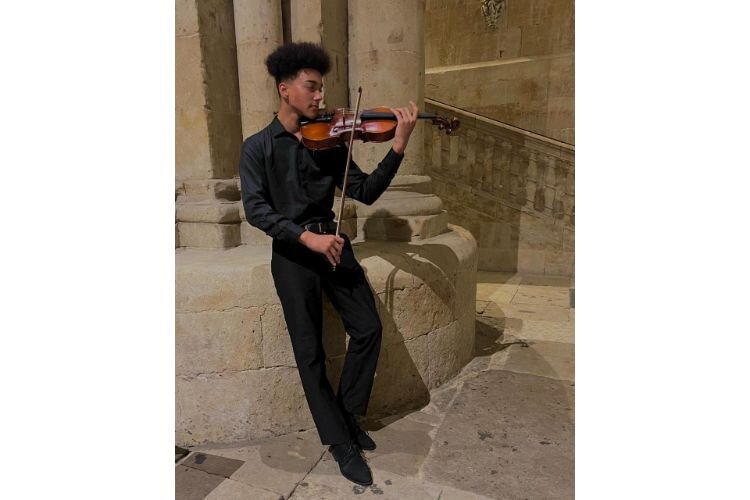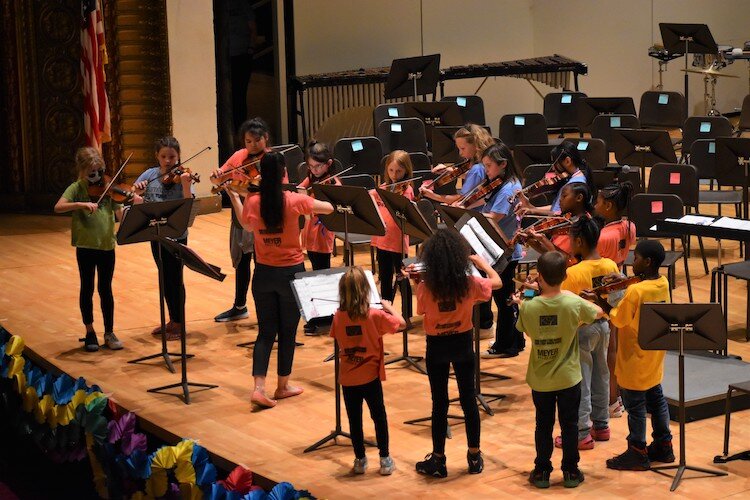KSO’s Kids in Tune: A nurturing pipeline to Kalamazoo Junior Symphony and beyond
Kids in Tune, sponsored by the Kalamazoo Symphony Orchestra, has been sharing the joy that comes with learning to play a musical instrument with students for 12 years. This El Sistema-inspired musical foundation has had a profound impact on over 1,500 students' lives.
Editor’s note: This story is part of Southwest Michigan’s Second Wave’s On the Ground Kalamazoo series.
It is said that music is an international language — but it is also an intergenerational language, crossing ages and even historical eras. In Kalamazoo, two programs go hand in hand to encourage music education in the youngest generations by teaching them about music from generations long ago.
At Woods Lake Elementary and Milwood Magnet School, in an after-school program called Kalamazoo Kids in Tune (KKIT), which is under the umbrella of the Kalamazoo Symphony Orchestra and supported by Kalamazoo Public Schools, students are given the opportunity to try different instruments and join a children’s orchestra.
Younger students meet four days a week after they finish their school day. Middle and high school students meet two afternoons per week during the school day.
“It begins with something of a petting zoo process,” says Ben Gudbrandson, artistic director of KKIT. “We invite the kids to try out the instruments and give them a test drive to see what they might like to learn to play. We have them fill out their top three choices and then have a honeymoon period with their first choice to cement their decision. If not, they can try their second choice. By the second or third week, they should have a solid choice of their instrument, although they can still change their mind later.”

Children either play their own instruments or are provided free instruments for their use by Meyer Music.
KKIT is built on the Venezuelan philosophy known as El Sistema, founded by Dr. José Abreu. Through passion and support, nurturing and joy, given a chance to know music intimately and personally, a child will learn life skills through the learning of music skills.
“We are incredibly fortunate that KPS, unlike many districts, offers both strings and band during the school day. KKIT extends that opportunity to after-school and summer for those who love it and also keeps kids involved who may not be able to take an ensemble in school. We had 125 students sign up last year, 1,654 students since KKIT was launched in 2011.”
If that doesn’t sound like a lot, Youker notes, it is because the retention rate is so high. It’s known among the participants that the kids who join stay on throughout their school years. The more they play, the more the passion grows.
KKIT performs four concerts per year along with a summer camp and special events. Families get involved and the kids are immersed in the world of classical music.
“All our music this past year has had a classical motif,” Gudbrandson says. “While we focus on the symphonic, we draw pop culture connections, and we compare similar elements in all types of music. Today’s music is culturally significant, but so is classical — it’s not a choice of one over the other.”

Jaykwon Noble can speak to that. He joined KKIT in his childhood years and is now a proud success story, working as an intern for the program while also playing first viola in the Kalamazoo Junior Symphony Orchestra — the next step up for those who have found their passion in music.
“I like all types of music,” he says. “I saw a show called Little Einsteins when I was 7 years old and got interested in classical. When I was in 4th grade, my first choice was cello, but it was huge to carry around, so my second was viola — instead of the violin because, well, I wanted to be different.”
Different, yes, and exceptional. By 6th grade, Noble had taught himself piano, and guitar, and finally took up that big, heavy cello as well. By high school, he added saxophone to his repertoire, but viola has remained his mainstay. His teachers took notice and lavished encouragement.
“Music became my form of self-expression,” says Jaykwon. “It was my stress release, like therapy.”

Noble was recently selected to be a part of the prestigious Youth Orchestra of Los Angeles’ National Festival, known as the YOLA National Festival, a 10-day orchestra intensive that brings together young musicians from El Sistema-inspired programs nationwide, providing them with world-class music instruction and mentorship.
“It was an out-of-this-world experience,” he says. “Stressful to put together a concert in 10 days, but fun. And I met great people and a great conductor.”
A budding composer, Noble graduated from KKIT and, encouraged to audition by his teachers, took the principal viola chair in the Kalamazoo Junior Symphony Orchestra (KJSO). Going into its 85th season, the third-oldest junior symphony continually running in the United States is the next step up for young musicians.
“We do three main stage performances a year and three string groups with their own concerts,” says Dave Crider, KJSO executive director. “We are different than school music programs because our students get to play symphonic works by the classics that they would otherwise never get to play. KKIT has no auditions, but (KJSO) auditions every June. It’s a very satisfying collaboration, a crossover for those who wish to go on with their music education.”
As with KKIT, KJSO makes an effort to make music accessible to all, providing scholarships for those who need them. Cost, Crider said, should never be a barrier. KJSO accepts students from nine counties and its program includes an overnight camp, as well as international tours.
“For some, perhaps classical music seems stuffy,” he says. “But others love it. It can be a little bit of a mystery why some students fall in love with it, and yes, there has been some attrition over the years, but I believe some of the love for it comes from it taking a lifetime to unpack — the melody, the harmony, the rhythm.
“Music can structure and enrich a young musician’s life. It’s also a communal experience, harmonizing with their peers, all working together to play music that is deeper, more complex.”

“Absolutely classical music can be a challenge, for both the musician and the audience,” Andrew Koehler said. He is the music director of KJSO, as well –“With our shorter attention spans now, young musicians can be easily distracted, but classical requires a sustained commitment. Students come in and blossom at different levels. There is no end to learning in this art form. They become entranced, and then, they catch fire. It’s the reward of mastering a skill.”
Koehler, too, points to Jaykwon Noble as the perfect example of what classical music can do for youth.
“Jaykwon has continued to push himself as he came up through KKIT and now in KJSO,” Koehler says. “More opportunities are unlocking for him. His peers elected him to the KJSO youth advisory council; he’s a full board member as a voice for his peers.”
Koehler acknowledges the valuable connection between KKIT and KJSO.
“KKIT is very inclusive, with an eye open for those who catch fire, but KJSO hones excellence for those wanting more challenge,” he says. “We both have our place in the ecosystem.”
Prominent musical alumni from KJSO have gone on to positions in the Symphony Orchestras of Chicago, Detroit, Houston, Seattle, San Francisco, and Liege (Belgium), to name but a few, but closer to home, KJSO alumni form substantial portions of the Kalamazoo and Battle Creek Symphony Orchestras, the Kalamazoo Philharmonic, and the Kalamazoo Concert Band.

A nonprofit, KJSO relies mostly on funding from foundation grants, corporate gifts, and private donations. KKIT is funded by the Irving S. Gilmore Foundation, Kalamazoo Community Foundation, Play USA, Marvin and Rosalie Okun Foundation, Suzanne Upjohn Delano Parish Foundation, PNC Foundation, and Zoetis.
For more information about Kids in Tune, see here. For more information about the Kalamazoo Junior Symphony Orchestra, including its upcoming concerts which all take place at Chenery Auditorium, please visit the KJSO website.















